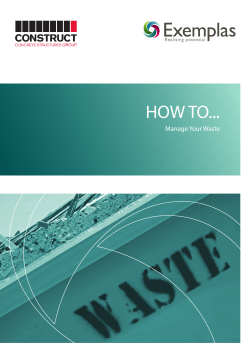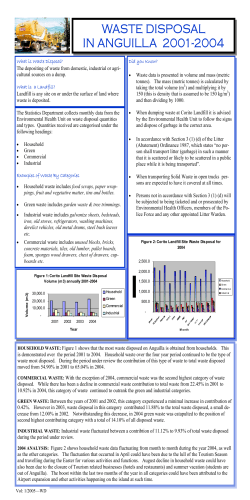
ENG Version - European Bioplastics
European Bioplastics e.V. Marienstr. 19/20 10117 Berlin FACT SHEET European Bioplastics e.V. APR 2015 phone fax e-mail web Marienstr. 19/20, 10117 Berlin +49.30.28 48 23 50 +49.30.28 48 23 59 [email protected] www.european-bioplastics.org LANDFILLING VR 19997 Nz, Amtsgericht Charlottenburg, USt-IdNr. DE235874231 HypoVereinsbank Rosenheim, BLZ 711 200 77, Konto 6356800, IBAN DE26 7112 0077 0006 3568 00, BIC/SWIFT HYVEDEMM448 FACT SHEET APR 2015 INDEX European Bioplastics e.V. Marienstr. 19/20 European Bioplastics e.V. 10117 Berlin phone fax e-mail web 1. DESCRIPTION OF TECHNOLOGY 2. CURRENT DISTRIBUTION Marienstr. 19/20, 10117 Berlin +49.30.28 48 23 50 +49.30.28 48 23 59 [email protected] www.european-bioplastics.org 3. LEGAL AND POLITICAL FRAMEWORK 3.1 Review of waste policy and legislation 4. INTERACTIONS BETWEEN BIOPLASTICS AND LANDFILLING 5. REFERENCES VR 19997 Nz, Amtsgericht Charlottenburg, USt-IdNr. DE235874231 HypoVereinsbank Rosenheim, BLZ 711 200 77, Konto 6356800, IBAN DE26 7112 0077 0006 3568 00, BIC/SWIFT HYVEDEMM448 2 FACT SHEET APR 2015 European Bioplastics e.V. Marienstr. 19/20 European Bioplastics e.V. 10117 Berlin 1. DESCRIPTION OF TECHNOLOGY A landfill is a site dedicated for the disposal of waste materials by burial. The following explanations on the technology refer to sanitary landfills for municipal solid waste. A sanitary landfill is isolated from the environment by measures to control the leachate and gas emissions. For this purpose, the landfill is equipped with a bottom liner and a surface seal. The bottom liner consists of several layers. As leachate forms and passes through the waste, organic and inorganic compounds become dissolved and suspended in the leachate potentially contaminating groundwater and surface water. For this purpose, landfills are equipped with drainage systems and usually also with waste water treatment installations. Marienstr. 19/20, 10117 Berlin phone +49.30.28 48 23 50 fax +49.30.28 48 23 59 [email protected] These emissions occur duee-mail to biochemical degradation processes of organic web www.european-bioplastics.org compounds and materials. From one tonne of household waste, around 111 m3 of landfill gas can be generated1. The gases produced within the landfill can be collected and flared off or used to produce heat or electricity. Typically, in the working face, the compacted waste is covered with soil or other materials, such as sprayed-on foam products or temporary blankets, on a daily basis. The cover is applied in order to minimise windblown-litter, control odours, prevent birds from scavenging, reduce the risk of fire and shed surface water and minimise contamination of runoff. After the landfill is closed, a cap is applied that prevents water from entering the site and gases from escaping. The surface is typically recultivated. Some of the most common usages are for parks, golf courses and other sports fields. Increasingly, however, office buildings and industrial uses are made on a completed landfill. The surface seal also consists of several layers, to prevent the leakage of one of the major environmental impacts of landfills, i.e. gaseous emissions of landfill gas. Landfill gas is approximately forty to sixty percent methane, with the remainder being mostly carbon dioxide. Landfill gas also contains varying amounts of nitrogen, oxygen, water vapor, sulfur, and other contaminants. 2. CURRENT DISTRIBUTION AND PROSPECTIVE OF TECHNOLOGY the levels are comparably low with 2-16 kg / capita. Norway (6), France (141) and Poland (186) constitute the middle range. In the outer regions of Europe, landfilling is a more important waste treatment option with per capita emergence of up to 421 kg (Bulgaria). Historically, landfills have been the most common methods of organized waste disposal and remain so in many places around the world. In Europe, the amount of Municipal Solid Waste (MSW) sent to landfill strongly varies from country to country. On average, 136 kg per capita2 are disposed of this way. In central Europe (Germany, Austria, Belgium, Netherlands, Denmark), 3. LEGAL AND POLITICAL FRAMEWORK The Waste Framework Directive 200/98/EC requires Member States to develop strategies for waste prevention. It defines a hierarchy of waste treatment options that ranks disposal (i.e. landfill and similar operations) as the least preferable way of waste management. The directive advises member states to take measures to encourage the separate collection of biowaste with a view to composting and anaerobic digestion3. the reduction of the amount of biodegradable wastes5 going to landfill to max. 35% of the amount in the reference year 1995 by 2014. that "only waste that has been subject to treatment is landfilled". In this context, treatment is defined as "the physical, thermal, chemical or biological processes, including sorting, that change the characteristics of the waste in order to reduce its volume or hazardous nature, facilitate its handling or enhance recovery". The landfill directive does not foresee a general ban of landfilling. Regarding legislation on member state level, a number of European countries have adopted landfill bans for specific categories of waste, such as organic waste or untreated waste in general.6 The European Council Directive 1999/31/EC ("landfill directive") sets the framework for the operation of landfill. It classifies landfills according to their risk potential4, defines rules for the permission, construction, and measures for the isolation from the environment, as well as for reporting and closure and after-care procedures. The most far-reaching provisions are: Literature review by Andreas Krieter: http://www.das-ib.de/mitteilungen/Krieter%20-%20Praxisprobleme%20bei%20der%20Deponieentgasung_DASIB_Bayreuth.pdf Source: Eurostat, data for EU 28 in 2012; the same for the following figures. WFD article 3 (4): 'bio-waste’ means biodegradable garden and park waste, food and kitchen waste from households, restaurants, caterers and retail premises and comparable waste from food processing plants. 4 Classes of landfill are: landfill for non-hazardous waste, landfill for hazardous waste, landfill for inert waste. 5 In contrast to the WFD, the LFD classifies also paper and cardboard as biodegradable waste. 6 19997 Nz, USt-IdNr. DE235874231 For anVR overview of landfill bansAmtsgericht and taxes in europe,Charlottenburg, please see http://cewep.eu/information/data/landfill/index.html 1 2 3 HypoVereinsbank Rosenheim, BLZ 711 200 77, Konto 6356800, IBAN DE26 7112 0077 0006 3568 00, BIC/SWIFT HYVEDEMM448 3 FACT SHEET APR 2015 European Bioplastics e.V. Marienstr. 19/20 3.1 European Bioplastics e.V. 10117 Berlin Marienstr. 19/20, 10117 Berlin phone +49.30.28 48 23 50 fax +49.30.28 48 23 59 hazardous waste landfills, corresponding to a maximum landfilling rate of e-mail [email protected] 25 percent. Having deleted web the “Circular Economy Package” from its 2015 www.european-bioplastics.org Review of waste policy and legislation In July 2014, the European Commission adopted a legislative proposal and annex to review recycling and other waste-related targets in several Directives. The proposal aims at phasing out landfilling by 2025 for recyclable waste (including plastics, paper, metals, glass and bio-waste) in non- agenda, the European Commission announced a new proposal for 2015. 4. INTERACTIONS BETWEEN BIOPLASTICS AND LANDFILLING Studies have proven that there is little risk posed by biodegradation of biodegradable bioplastics in landfills.7 Most bioplastics remain inert in landfills, where they potentially sequester carbon. Landfilling remains a widely applied method of waste treatment in Europe, with large variations between member states. About 38 percent of all post consumer plastics waste in Europe is buried in landfills and neither the material value nor the energy content of the plastic material is utilised.8 The findings for a biodegradable and compostable, starch based film were that a humidity of 65 percent is required to trigger the biodegradation.10 At lower levels, there is no biogas evolution. The cellulose, used as reference material, showed significant biodegradation at humidity levels of 55 percent, but no biodegradation at 40 percent. It should be noted that the family of biodegradable plastics comprises a big range of materials and that test results exist only for few materials. Some bioplastics companies conducted studies of the biodegradation behaviour of their materials in landfill according to the ASTM D 5526 standard9. This test method has been designed to assess biodegradation under optimum and less-than-optimum conditions. For all types of bioplastics, more favourable options than landfilling exist, i.e. recycling or composting. A ban on / phase out of the landfilling of recyclable and highly combustible waste would stimulate the recycling and energy recovery of plastic waste. 5. REFERENCES ISWA, International Solid Waste Association, The Landfill Operations Guidelines, 2nd Edition 2010. European Commission. Information on Waste: Landfill: http://ec.europa.eu/environment/waste/landfill_index.htm April 2015 European Bioplastics e.V. Marienstraße 19/20 10117 Berlin Phone: +49 (0) 30 284 82 350 Fax: +49 (0) 30 284 84 359 [email protected] www.european-bioplastics.org Kolstad, Vink, De Wilde, Debeer: Assessment of anaerobic degradation of Ingeo® polylactides under accelerated landfill conditions, 2012 PlasticsEurope: Plastics – the facts 2013. Numbers for 2012. ASTM D5526 “Standard test method for determining anaerobic biodegradation of plastic materials under accelerated landfill conditions” 10 Source: Organic Waste Systems Study FDI-41 (sponsor Novamont) Oct. 5, 2007. Study according to ASTM 5526. 7 8 9 VR 19997 Nz, Amtsgericht Charlottenburg, USt-IdNr. DE235874231 HypoVereinsbank Rosenheim, BLZ 711 200 77, Konto 6356800, IBAN DE26 7112 0077 0006 3568 00, BIC/SWIFT HYVEDEMM448 4
© Copyright 2025













